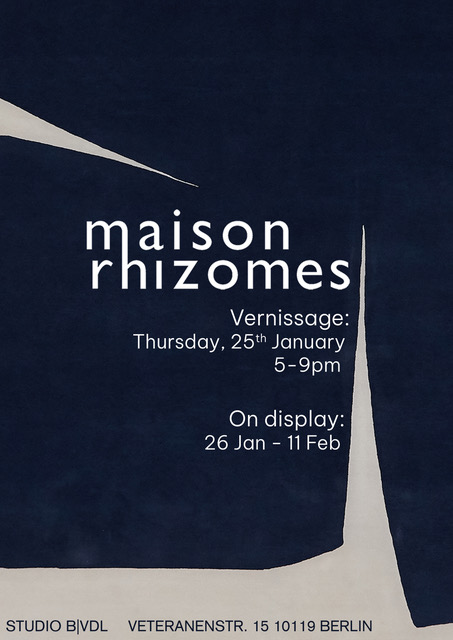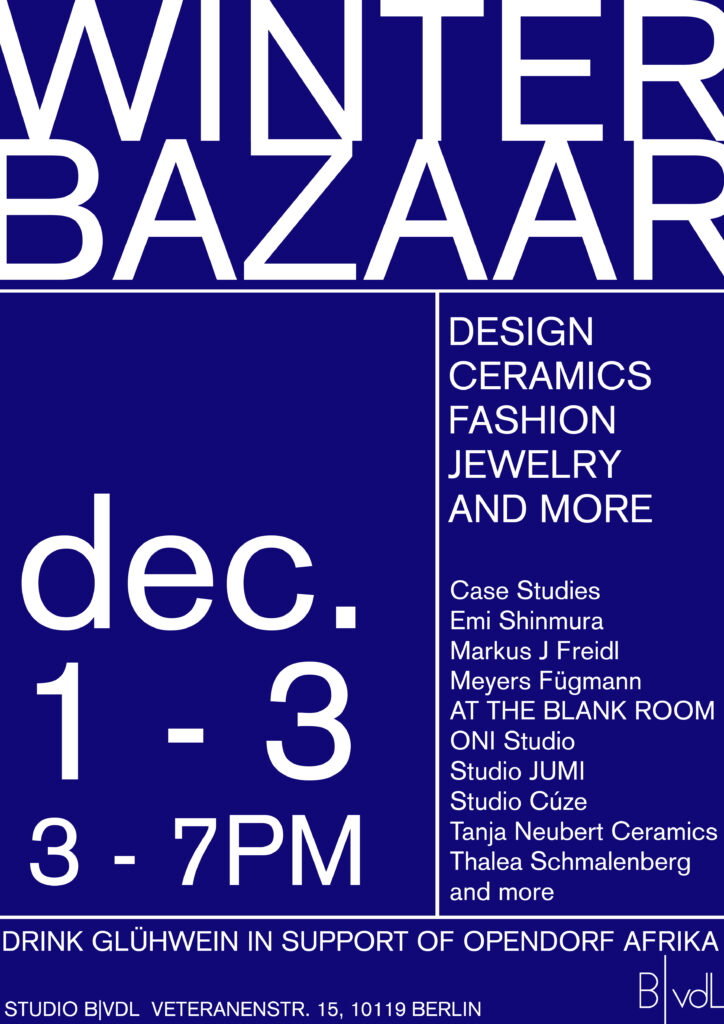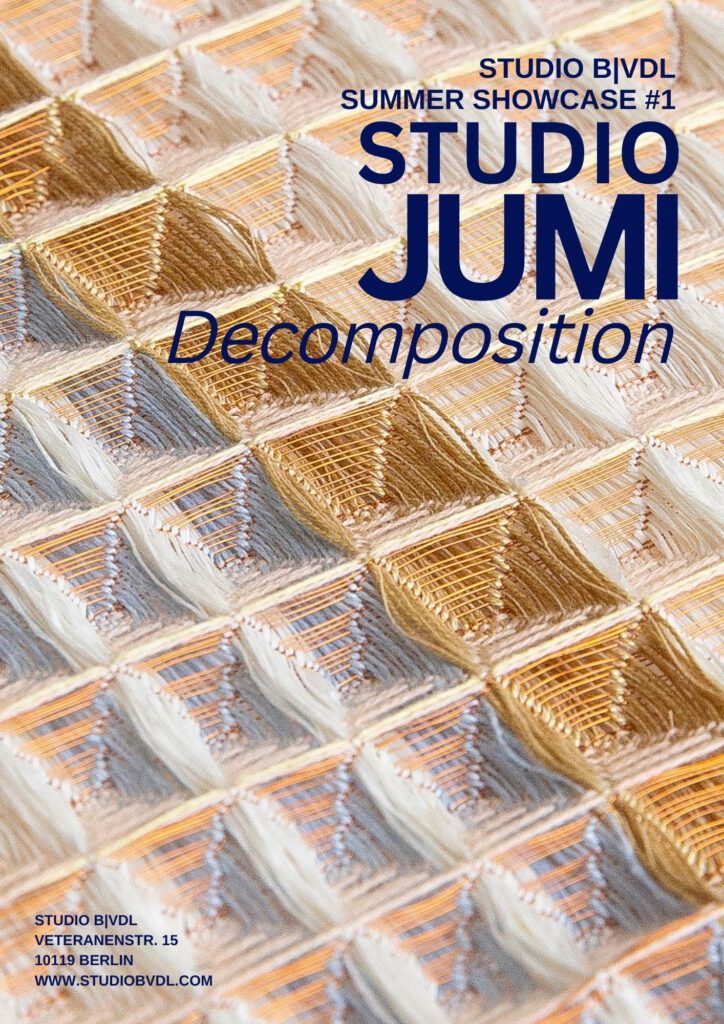Studio B|vdL presents MAISON RHIZOMES

Join us as we introduce Maison Rhizomes’ collection of hand- knotted art rugs for the first time here in Germany. We will be showcasing the collection of Belgian painter and Co-Founder Charlotte Culot and officially launch “Blue Breath” by French painter Ludovic Phillipon.
To tell Maison Rhizomes’ story, one needs to look back to the year 2018 when Belgian painter Charlotte Culot had a crush on a Le Corbusier tapestry at Chateau Lacoste, Provence. Inspired, she felt the urge to transform her work into a more tangible medium. With this intention, serendipity led her to the right people. The first piece was exhibited in 2019, and since then, the collection has continued to flourish. In the same year, Charlotte and Hannah, today’s co-founder of Maison Rhizomes, crossed paths in the mountains of Nepal.
Finally, in 2022, Maison Rhizomes was officially launched as a studio for art rugs of limited edition, with the aim to collaborate with established artists and extend their oeuvre into the medium of rugs. This journey culminates in the launch of “Blue Breath” by French painter Ludovic Phillippon, the first artist to join the team.
Maison Rhizomes sees each rug as a work of art, bringing value to any space – whether on the wall or on the floor. All the rugs are hand-knotted in Nepal or India, limited to twenty-two pieces. They communicate the dedication to blending craftsmanship and artistry in each design echoing the commitment to create something that remains.
On display
January 25 – February 11
Fridays and Saturdays 2-6 pm or by appointment.
Studio B|vdL presents Winter Bazaar

Studio B|vdL invites you to our 2023 Winter Bazaar. Once again the Studio B|vdL showroom will be filled with works from a range of Berlin designers and makers. This year joining us at the bazaar will be:
Case Studies / Emi Shinmura / Markus J Freidl / Meyers Fügmann / AT THE BLANK ROOM / ONI Studio / Studio JUMI / Studio Cúze / Tanja Neubert Ceramics / Thalea Schmalenberg
To keep you warm we will have homemade Glühwein for sale, with proceeds going to support Operndorf Afrika. longside the bazaar our latest exhibition, ‘Oscillations’, from Berlin textile studio Case Studies is on display. Showcasing their new series of works, alongside collaborations with Studio B|vdL and Original in Berlin. As always our showroom has classic vintage furniture and rugs, and a range of architectural products for sale.
We look forward to all coming together again and hope to see you there.
Winter Bazaar
December 1-3
3-7pm
Studio B|vdL presents Oscillations by Case Studies

Studio B|vdL presents the new series ‘Oscillations’ by Berlin-based textile studio Case Studies, including new collaborations with Original in Berlin and Studio B|vdL.
An innovative studio based in Berlin, Case Studies occupies a prominent position in textile design, specializing in imaginative knitted creations. Through a meticulous approach to material exploration and colour analysis, they craft a vibrant realm of dynamic patterns and gradients. Case Studies is renowned for its collections that seamlessly traverse the domains of interior design and apparel, appealing to a broad spectrum of aesthetic sensibilities. Their frequent collaborations with various design firms showcase their expertise in 3D-knitted textiles and their ability to redefine the boundaries of textile art within project contexts.
This exhibition showcases the newest collection from Case Studies; ‘Oscillations’.
The use of oscillating and overlapping line formations throughout the works creates a moiré effect whose graphic quality is reminiscent of the OP Art Era. These unique linear formations give a super-imposed essence to the work that is in constant flux, shifting and changing with the viewers perspective and incidence of light. Organic qualities of water and natural wood give the work a natural grounding, conversing with other pieces in the room.
As part of the ‘Oscillations’ series, Case studies is excited to exhibit new collaborations with two Berlin design outfits.
Working with Studio B|vdL on their daybed, a new knitted fabric was developed for the mattress component. Inspired by the mattresses yellow colour combined with pastel shades, this new cover aims to make a contemporary statement. In addition, the moiré effect of the pattern is in conversation with the natural wood grain of the oak frame. Developed with sustainability in mind, the material is a combination of soft Italian merino wool and a robust recycled PES.
The second collaboration on display is with vintage store Original in Berlin. The work, an iconic mid-century ‘Gondola’ sofa by US designer Adrian Pearsall, has been reupholstered in a new textile that references tradition with a trendy feel. The dynamic graphic pattern is combined with bold retro colours to create a vibrant and exciting new piece. The cover consists of a soft Italian merino yarn coupled with high-quality viscose and a PES filament to provide stability, whilst in the back cushions a hairy effect yarn is used to create a sophisticated sheen and softness.
The ‘Oscillations’ series extends into interior products and accessories such as pillows and blankets, which are now available for purchase at the Studio B|vdL Showroom.
On display
November 23 – January 5
Fridays 2-6pm or by appointment.
or as part of our Winter Bazaar December 1-3, 3-7pm.
Studio B|vdL presents Susanne Schwieter

Against the backdrop of the ever-evolving relationship between humans and technology, the exhibition CURRENT QUARRY illuminates processes of identity shift between analog and digital images. These shifts manifest in linguistic, visual, and physical forms. Artist Susanne Schwieter addresses the question of what technological advancement, digital thinking, and a growing image archive mean and achieve in a societal context. The close interconnection between the analog and the digital plays a pivotal role.
At the heart of the exhibition lies the long-running series of works titled “Cruiser,” a set of large-format paintings that emerged from a Google image of a marble block in the Carrara quarry. They are abstract, the original motif no longer decipherable, emphasizing the ephemeral nature of images, language, and ultimately identity. These works engage with questions of legacy and copyright in the digital age, as well as the act of appropriation.
Schwieter’s approach is intuitive, with motifs emerging in an ongoing process. Each work within a series consistently references a shared photographic source. Shapes and silhouettes move from one work to the next, akin to actors in a theatrical performance. This dynamic continues in the CURRENT QUARRY exhibition, where the works span all the spaces across the two levels and engage in dialogue with one another.
On display
September 15 – October 19, 2023
By appointment only.
book now
Studio B|vdL Summer Showcase #2 Elizabeth Charnock

Elizabeth Charnock’s exhibition at Studio B|vdL explores the overlap between art and architecture. She presents drawings, sculptural pieces and videos from the last 8 years, spanning her time spent studying in Dresden to her current Berlin-based practice. Though continuously evolving in style, her work has been consistently influenced by her interest in the urban environment and spatial relationships within it.
By referencing a large body of documentary photography, she mentally collages multiple architectural elements into imagined environments, meticulously rendered with multiple layers of ink on paper, or sculpted from ceramics. As artist rather than architect, she is free to imagine these scenes in any way she chooses, hence real-life constraints of scale, perspective and functionality become extraneous.
Her work is often self-referential, the drawings acting as the plans for architectural models or vice versa. She captures moments ‘in-between’ – miniature snapshots of inactivity and tranquility before or after human interference. The viewer is left only with traces of events, inviting us to form our own narrative. The uninhabited spaces evoke feelings of isolation, offering familiarity – but only at a distance – whilst also inviting us to reassess our own sense of place within these miniature worlds.
Originally from the UK, Elizabeth Charnock has lived and worked in Berlin since 2015. She completed a bachelor’s degree in Art and Design at the University of Leeds and was awarded an academic scholarship by DAAD in 2014 to continue her studies in Fine Art at the Dresden Academy of Fine Arts. She has exhibited in Germany, Poland, Italy and the United Kingdom.
Studio B|vdL Summer Showcase #1 Studio JUMI – Decomposition

Studio JUMI is a Berlin-based weaving studio working at the interface of art, craft and design. In their joint work, the artists Julia Buntzel and Miriam Rose Gronwald are committed to the preservation of traditional hand-weaving as well as its further development as a visual art.
The fundamental method of weaving is the interlacing of two individual thread systems crossing at right angles to each other. The warp threads are stretched vertically across a loom and are individually threaded through the eyes of a heddle. Groups of heddles hang on frames called harnesses. The tie-up of the foot-operated treadles with the harnesses enables the raising and lowering of the warp threads, creating a shed through which the weft thread passes.
Weaving is one of the oldest crafts in the world and it has been developed and optimized over many generations and by many cultures worldwide. The recent ‘artification’ of the craft has allowed the process of creating a fabric to be perceived as a free, creative medium rather than simply as the manufacture of a necessary product. Form and utility, which play an overriding role in product design and manufacture, recede into the background as the artistic context is prioritized. Combining unconventional and recycled materials from the textile industry and other sources with traditional pattern drafts, Studio JUMI aims to strip hand-weaving of its practical interpretation to instead highlight its broad technical and creative potential.
In the Studio BvdL exhibition Decomposition, Studio JUMI pushes the boundaries of the medium by the fragmenting, dissolving, and condensing the grid-like structure of the woven fabric. The displayed works include Open Archive–an ongoing collection of weaving samples created in the course of their research process—as well as a translucent wall hanging and three-dimensional surface structures.
Studio JUMI is strongly influenced and inspired by the former weaving workshops of the Bauhaus School in Weimar, Germany and Black Mountain College in North Carolina, USA, and by the works of textile artists such as Anni Albers, Gunta Stölzl, Sheila Hicks and Leonore Tawney, who combined the craft of hand-weaving with the language of modern art. Their knowledge influenced and was transferred to many other art and design forms. Today, given the growing interest in hand crafts as well as the need for sustainability and a more conscious approach to consumption, the role of weaving workshops and the potential of the woven fabric itself are being perceived in a new light.
Stay connected with Studio B|vdL by signing up for our newsletter.